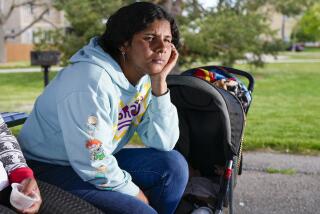Catholic Shelters Provide Help for the Homeless, Malnourished : Addicted Street Children Pay Price for Bolivia’s Drug-Based Prosperity
- Share via
COCHABAMBA, Bolivia — When this city of 350,000 goes to bed, it is time for Sister Stephany and Father Henry to load bread and plastic jugs of hot milk onto their pickup truck and set out into the night.
They go in search of the hundreds of children whose only home is the streets.
A third of the children they will find, some as young as 5, are cocaine-paste addicts or sniffers of glue or gasoline. Others have been abandoned by their parents or come from homes of unemployed workers where there is not enough food. Many survive by selling cigarettes laced with cocaine paste or by petty thievery.
Drug Prosperity
At least 2,000 children and youths roam the streets of this city, which is prospering from the cocaine produced in the Chapare, a subtropical region 110 miles to the northeast, where 80% of the coca leaf grown in Bolivia is processed into cocaine.
When Sister Stephany Murray, 68, who was born in Emmittsburg, Md., and the Rev. Patrick Henry, 47, of Omaha, find the children, they pass out the bread and the hot milk in plastic cups.
“Distributing milk gives us a chance to make contact with them and make them feel we are indeed interested in them and they are not outcasts of society,” Murray said. “It is a friendly contact. If they are on drugs we try to tell them they can do better and we are ready to receive them when they are ready to come.”
She and Henry operate two Roman Catholic Amanecer (Dawn) shelters for homeless youths.
Murray, a member of the St. Vincent de Paul Order, has been working in Cochabamba for 25 years. Henry is on leave from the Roman Catholic Archdiocese of Omaha to work as a Maryknoll missionary in Cochabamba. He has been here five years.
They said they distribute bread and milk to 150 to 200 children two nights a week.
“Some of the kids leave home because there is nothing to eat,” Murray said. “They start shining shoes, they lose contact with their families and they find it easier to steal or sell cigarettes laced with cocaine paste.”
Organizations that work with homeless youths say the number of street children and cases of youth drug addiction in Cochabamba and other cities have increased in the last five years chiefly because of Bolivia’s economic difficulties and the availability of drugs.
Unemployment is more than 20%, 35,000 government workers have been laid off in the last five years as part of the government’s austerity program and, according to the United Nations Children’s Fund, 45% of rural children suffer from malnutrition.
The Amanecer centers provide temporary lodging for street children, along with rehabilitation and training programs.
“Just about everybody on the streets has used drugs and practically all of them have had involvement in drug trafficking,” Henry said.
Several of the youths interviewed at an Amanecer shelter said they had worked in the cocaine-producing Chapare region. They told of being arrested by police and taken to a labor camp for drug offenders in the Chapare. At least five youths have died at the camp under suspicious circumstances in the last two years, Henry said.
“Children in the Chapare transport chemicals while their parents as well as youths macerate coca leaves into cocaine with the first priority being to provide food to live on,” said Laura Baldivieso, a psychologist and head of the U.S.-financed Drug Information Center. “But the Chapare, instead of resolving the economic problems of the unemployed, is contributing to a deterioration of the family and the social structure.”
“Many of the kids who come to our center have tread on coca leaves in the Chapare,” Henry said. “They are paid $20 a night to stomp on coca leaves and often part of the payment is in the form of paste.”
Many youths arrive from the Chapare with festering wounds or ill with parasite-borne diseases, yellow fever or tuberculosis, Henry said.
“They become exhausted from working all night and for lack of food,” he added.
“Five years ago people would say that drugs were a North American problem. They can’t say it anymore because drug use has become so much more widespread and there is cocaine everywhere.”
After midnight on El Prado, a tree-lined avenue bordered by restaurants and snack shops, Quechua- and Aymara-speaking Indian children roam the streets, often selling paste-laced cigarettes for traffickers to people from all social classes.
Police cars sometimes stop to question them, but Murray said they often threaten to take the children to jail unless they hand over money, usually the equivalent of $5.
“Street kids tell me, ‘If I don’t have the money, I will be mistreated so I better have enough,’ and this encourages stealing,” she said.
Children Jailed
Although it is illegal to put a child in jail, the organization Defense for Children-International says dozens of children are rounded up every night and kept overnight or several days without food or blankets in dark and filthy jail cells alongside hardened criminals.
“At its base, the cocaine and street kid problem in Cochabamba is an economic one,” Henry said. “Unfortunately there is no industry that can take up the slack if cocaine stopped. It would be an overwhelming switch to have all these people come back from the Chapare when there are no jobs. There are people who are desperate and are living a very thin line. They won’t get rich, but at least they will feed their families.”
More to Read
Sign up for Essential California
The most important California stories and recommendations in your inbox every morning.
You may occasionally receive promotional content from the Los Angeles Times.










